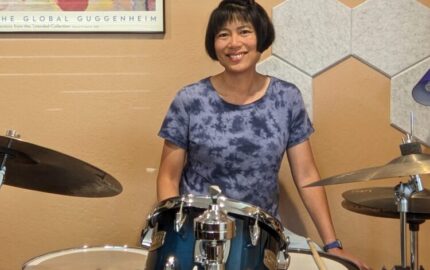We’re sitting on folding chairs around a scarred table, the linoleum veneer curling at the edges, in an airless, windowless room. It’s me and nine men, ranging in age from 38 to 81, all of whom, decades ago, did something that landed them here, in a maximum security prison, for sentences ranging from 25 years to forever. Their heads are bent over sheets of looseleaf paper, their hands are gripping pencils.
They are writing.
That’s what happens in this room for two-and-a-half hours every other week. They write. Then they read aloud from their work and listen as others read. They comment: dark humor, in-jokes, shared experiences, editorial insights. Meanwhile, I jump (lightly) on the teaching moments as they occur, and these men begin to learn the art and craft of narrative nonfiction, of storytelling journalism.
Those of us who do this for a living, do this work — and it is work — because we love it, because it feeds our curiosity, because it helps us understand people and community and our world (and we hope it does that for others), because we believe journalism is a cornerstone of democracy. Because we get paid. And because we tell ourselves we not really good at anything else.
But what about these men,? Why do they swelter and hunch over paper in this room? Why do they show up to write, to learn, to edit, to revise?
And what might we, the professionals, learn from them?
Finding your voice and story
These men are locked cages. They live their lives behind a 30-foot-high concrete perimeter wall. With the exception of one, they did not come to the group I started at Oregon State Penitentiary thinking of themselves as writers. Although we met — as writers —for two-hour sessions twice a month until the pandemic shut us down, their identity was consumed by their circumstance: They were inmates. They were prisoners or, as the Department of Corrections decided to rename them in what the men consider a laughable euphemism, AICs, or “adults in custody.” Most held a romanticized or idealized vision of what it means to be a writer, a sense that writing flows naturally from those blessed with talent. Most were unschooled. Most had never been exposed to great writing. (More on this later.)
Most held a romanticized or idealized vision of what it means to be a writer…
Shut away from the world, they became invisible. They were voiceless. And they knew just how invisible and voiceless they were.
Journalists are often stymied in our attempts to make the world of incarceration knowable to our readers — prisons keep people in and media out. But we do have a platform from which to speak, both professionally and personally. Working with these men over the course of three years, I was reminded again and again of my privilege of voice, my professional platform (yes, of course, some of it not just privilege but also the result of decades of hard work). These reminders reenergized my sense of responsibility to use my time and experience as a reporter in ways that might make a difference. This is why I went on to write two books about the challenges of life in prison and the challenges upon reentry into life taken for granted by the rest of us.
But these men were hunched and scribbling in this room because they wanted and needed to tell their own stories.
When they showed up for the writers’ group, they weren’t thinking in these terms. They weren’t thinking “I have a story to tell,” because they did not think of themselves as writers, and they did not think of their experiences as the plot of a nonfiction story they could craft. It was my job to help them see that. In framing their experiences this way, in slowly learning how to commit snippets of their lives to words on paper, they were, without realizing it at first, taking control. If they could write the narrative, they might be able to change the narrative, to imagine a different life, to write a new chapter, to move forward.
If they could write the narrative, they might be able to change the narrative …
In learning to write about their experiences, both before and during incarceration, the imprisoned men learned what we trained-as-hard-news journalists are continuing to learn and practice: Story is the way to reach people, and details bring issues to life. At first their writing was dry — recitations, a summaries, paragraphs of explanation. But when they read aloud, others in the group chimed in with actual stories. The conversations turned lively. And the door opened wide for me to talk about the emotional connection a story can forge with readers, how scenes and action and dialog can bring a reader into a moment.
Internal and external obstacles
But they faced obstacles we professionals do not. The first was education. Data from the National Former Prison Survey reveals that more than half of incarcerated people hold only a high school diploma or GED, and a quarter hold no educational credential at all. To what extent high school classes actually teach a student to write is debatable, but at least writing is required, from long-form answers on tests to essays and term reports. That was not part of most of imprisoned men’s experience, so their knowledge of and confidence about the fundamentals — language use, vocabulary, grammar — was at a low ebb. It was an act of bravery, or maybe hubris, for them to put words on paper. But over time, I believe this helped them foster a belief in themselves.
A related obstacle was their exposure, or lack thereof, to good writing. Prison libraries are underfunded, understocked and understaffed. The material on the shelves skews to self-help (addiction, anger management, etc.), religion-based inspirational work and what I think of as “recreational fiction.”
It was an act of bravery, or maybe hubris, for them to put words on paper.
So when we started to talk about crafting scenes to make a story come alive, most of the men had never read a piece of narrative nonfiction or storytelling journalism. But learning by example is so important. Outside prison walls, we get to do that every day as we read great journalism, listen to storytelling podcasts, immerse ourselves in books based on meticulous reporting. To be a writer, you must be a reader.
So one of my tasks became bringing books and articles into prison. This was not easy. Reading material is strictly controlled; inmates can be cited for an infraction (and lose privileges or worse, spend time in solitary) for having an unapproved book or magazine in their cell. You may have also read about the growing wave of book banning in prisons. I was not bringing in anything incendiary, but bringing in anything at all (a pencil, a candy bar) is problematic, sometimes seriously so. Had it not been for the extraordinary support of one prison staffer — a man who, despite working in the belly of the beast, believed in education, rehabilitation and second chances — I could not have done this.
During the three-plus years the group met, I was able to bring in, item by item, almost 100 narrative nonfiction books and articles. The men had eclectic tastes, ranging from the gritty Vietnam memoir “Zero Dark Thirty” to Susan Orlean’s quirky biography of “Rin Tin Tin.” They loved Tony Horowitz’s “Blue Latitudes,” and were fascinating by Mary Roach’s “Gulp.” “Geez,” one of the men told me after reading Roach’s exploration of the alimentary canal in two days. “I guess a good writer can make anything interesting.” The prison’s furniture hobby shop provided us with a locked cabinet for the “writers’ library.” One of the men took on the role of the librarian, signing out material and tracking returns.
The men, when given opportunity, access and choice, turned out to be eager, hungry, voracious readers. Starving, in fact. The way we all should be. The way I wish I still was. I read so much now for research and reporting that my other reading — primarily the work of journalists and nonfiction authors I greatly admire — is relegated to the final 20 minutes before slumber. I want to take a lesson from the men and become hungry again. Maybe you are ready for that as well?
Writing lessons from non-writers
Here is another lesson these prisoners have for those of us who write as our profession: Because they did not think of themselves as writers, they did not suffer the ego problems that hound us. Their humility and openness to constructive criticism — not to mention tough editing — was beyond admirable. I have worked with some fine editors (top on the list is the editor of Nieman Storyboard), but I also have resisted and fought editing — some of it probably pretty decent — because I was too in love with my own words.
These men were sponges for the editing process. They delighted when they received their work back covered in ink. They asked for more. Some of the work ended up being published; some won awards. These pieces, and hundreds of others that never saw the light of day outside those walls, went through multiple revisions. I believe the record was seven.
Of course, these men had time — a dark-humor joke they frequently made when faced with another revision — that working journalists often do not. But it was their eagerness, their openness to actual revision (literally “seeing again”) that was so refreshing.
A final lesson from these caged writers, especially for those of us who freelance — which means we labor over detailed pitches that don’t get green-lit, or who write books, which means we labor over 10,000-word proposals that go nowhere: It is not publication that makes a writer. It is writing. It is the act of seeing and hearing, of recording and remembering, of shaping.
As I told the men so many times and as I struggle to remind myself. Maybe you can use a reminder, too, this one from Marge Piercy:
The real writer is one
who really writes…
Work is its own cure.
* * *
Lauren Kessler is an Oregon-based narrative journalist, teacher and author of 15 nonfiction books.



